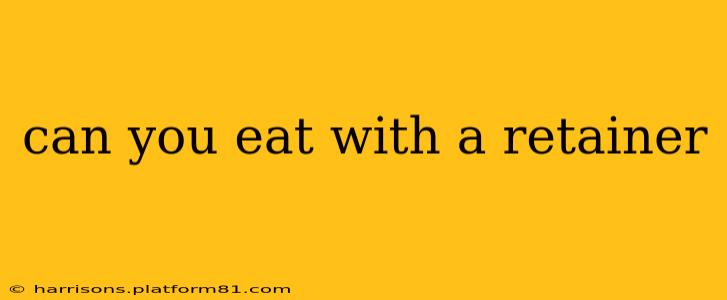Can You Eat With a Retainer? A Comprehensive Guide
Many orthodontic patients wonder about the intricacies of daily life with a retainer. A common question, and a crucial one for maintaining oral hygiene and the longevity of your retainer, is: can you eat with a retainer? The short answer is: generally, no. While there are exceptions, eating with a retainer is strongly discouraged. Let's delve deeper into why.
What Happens If You Eat With Your Retainer?
This is a key concern for many people newly fitted with a retainer. Eating with your retainer can lead to a number of problems:
-
Damage to the retainer: Hard foods can crack, chip, or break your retainer. Sticky foods can become trapped and cause discoloration or bacterial buildup. Even seemingly soft foods can exert surprising pressure, potentially warping the retainer over time. This damage can render your retainer ineffective and necessitate costly repairs or replacement.
-
Food trapping and bacterial growth: Food particles can easily get lodged between the retainer and your teeth, leading to plaque buildup and an increased risk of cavities and gum disease. Removing these particles thoroughly can be challenging, even with meticulous brushing and flossing.
-
Discomfort and pain: A retainer that's warped or damaged can rub against your gums and teeth, causing irritation, soreness, and even pain.
-
Retainer becoming dislodged: The act of eating, especially biting into something firm, can cause your retainer to shift or even pop out entirely. This can be inconvenient and frustrating, and could disrupt the alignment of your teeth.
What Foods Can You Eat With a Retainer? (With Cautions!)
While generally you shouldn't eat with your retainer in, some exceptionally soft foods might seem acceptable. However, even with these, extreme caution is advised. These should only be consumed if absolutely necessary and only after careful consideration and following these recommendations:
-
Extremely soft foods: Think yogurt, applesauce, or very well-cooked mashed potatoes. Even then, consume slowly and mindfully, ensuring no biting or chewing is involved.
-
Immediate removal post-consumption: Remove the retainer immediately after eating, even if it was a "safe" food. Rinse it thoroughly and brush your teeth.
It's far safer to remove your retainer before eating, then clean it and put it back in afterward.
What are the best practices for retainer care?
Maintaining your retainer's integrity and your oral health requires diligent care. This includes:
-
Brushing your retainer: Brush your retainer at least twice a day with a soft-bristled toothbrush and non-abrasive toothpaste. Avoid harsh chemicals or abrasive cleaners.
-
Soaking your retainer: Soak your retainer in a retainer cleaning solution as directed by your orthodontist. This helps remove food particles and bacteria.
-
Storing your retainer: When not in your mouth, keep your retainer in its case to protect it from damage and prevent loss.
How Often Should You Remove Your Retainer to Eat?
Ideally, you should remove your retainer every time you eat or drink anything other than plain water. This will minimize the risk of damage, food trapping, and oral health issues.
Should I consult my orthodontist?
If you have any concerns about eating with your retainer or have any questions about retainer care, consult your orthodontist. They can offer tailored advice based on your specific retainer type and oral health needs.
By following these guidelines and prioritizing proper retainer care, you can ensure the longevity of your retainer and maintain a healthy, beautiful smile. Remember, prevention is always better than cure when it comes to your orthodontic investment.
